This gentle bastille baby soap recipe is great for baby's delicate skin and anyone with sensitive skin. It's super charged with skin loving ingredients like chamomile infused olive oil, Shea butter and colloidal oatmeal to gently cleanse the skin without stripping it of it's natural barrier mantel.

I’ve been making this baby soap since way back when our first child, who's prone to eczema in the winter, was a wee toddler. These days we all use it, especially when everyone’s skin is crazy dry and itchy. For our littlest however, I like to use my gentle coconut milk bath and only use the soap very sparingly.
I have to let you know that it's not a tear-free soap. If you get it into your eyes it will still sting despite being gentle.
How to Formulate a Gentle Soap
In cold process soap making certain oils and butters are carefully chosen depending on their cleansing, moisturizing, hardening and lathering abilities.
Cleansing power usually comes from coconut oil (or sometimes from babassu or palm kernel oil) which also adds hardness and bubbly lather to a bar. Coconut oil however can be a little too drying for folks with sensitive and/ or dry skin, depending on how much is used in a soap.
Moisturizing properties mostly come from liquid base oils (like olive oil, sunflower oil, sweet almond oil etc.) and luxury oils (like argan, jojoba, hazelnut, etc.). But since they're liquid oils they don't contribute much hardness to a bar of soap, nor do they lather well. They are however wonderful for your skin and will soften and nourish it.
Hard oils (like palm oil, babassu and tallow) and butters (like cocoa, shea and kokum butter) are usually chosen for their hardening as well as their skin conditioning properties.

For abundant bubbly lather the go to oil is coconut oil. It produces big empty bubbles that pop up quickly after the soap gets in contact with water. It will leave your skin squeaky clean.
There’s another oil though that is popular for its lather boosting power: castor oil. Even a small amount of castor oil will improve lather by producing small creamy stable bubbles. Unlike coconut oil, castor oil is a soft oil with lots of skin conditioning properties.
With all that being said, how do we formulate a gentle soap recipe? The obvious choice is to omit or reduce the amount of coconut oil used in a recipe and replace it with a good amount of nourishing liquid oil(s).
If you’re wondering whether the soap will then still have cleansing abilities, rest assured: soap is still soap after all. It will simply cleanse in a less aggressive way.
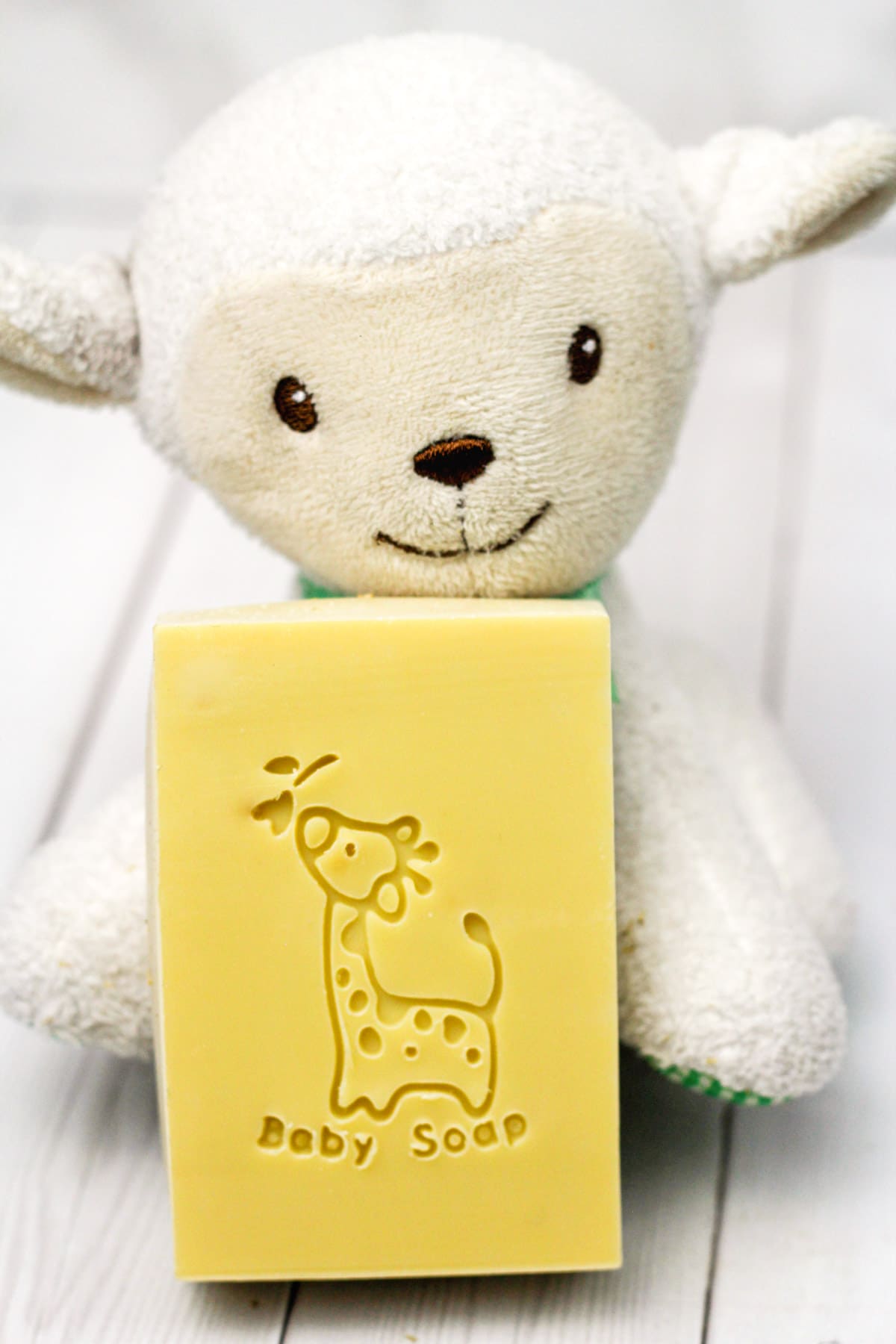
What’s Bastille Soap?
Probably the best known "single oil soap" is Castile soap. A soap that is made entirely (100%) from olive oil named after the Castile region in Spain where the soap is said to have first originated . While Castile soap is the most gentle soap for your skin it also has it's downsides.
A soap made from olive oil has a very particular lather...slimy. Yes, the lather will improve over time as the soap cures and hardens , but this can take between 6 - 9 months!
For this gentle baby soap recipe I chose to formulate a Bastille Soap which is mainly (at least 70%) made of olive oil but uses the addition of other oils and butters for lather, hardness and moisturizing properties.
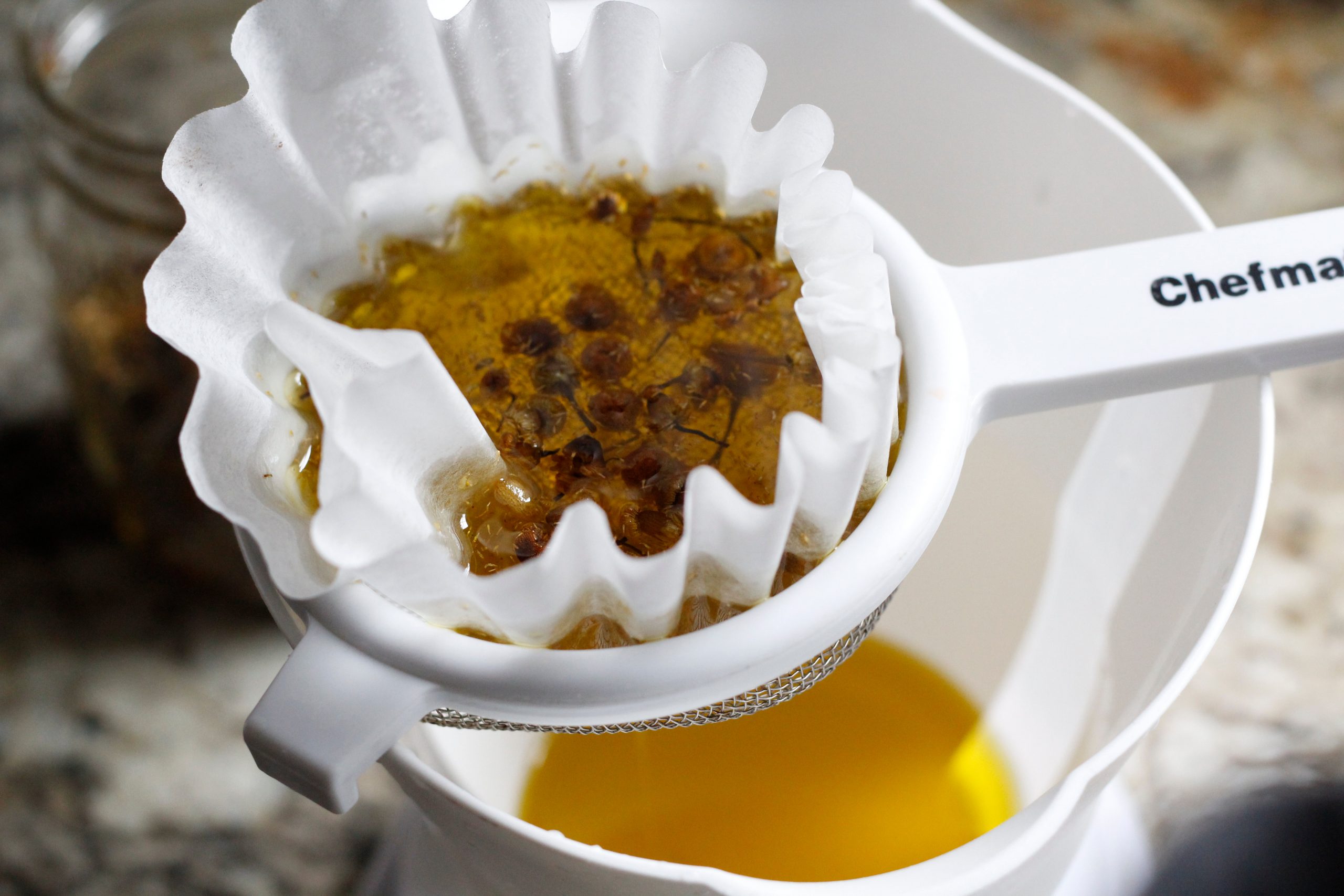
How to Make Oil Infusion
There are two ways to infuse dry herbs or flowers into oil: Cold or heat infusion. Both methods start with combining plant material with oil in an airtight glass container.
So, for this recipe you would take ¾ cup of chamomile flowers, place them on the bottom of a mason jar, add 12.35 oz. (350 g) of olive oil, close the lid tight and give it a good shake.
Now, depending on how much time and patience you have, you can either:
a) place the mason jar on a sunny window sill for 3-4 weeks, or
b) fill a saucepan with a couple of inches of water, stand your mason jar in it, put it on a very low simmer for 2-3 hours. For this method you will have to check on your oil frequently and make sure the water hasn't evaporated.
After the chamomile is done infusing the oil, it's time to strain the lavender buds. I used a colander that I lined with a coffee filter, but you can use a cheese cloth or very fine sifter instead. Make sure that you squeeze as much olive oil as possible out of the chamomile at the end.
How to Use Acrylic Soap Stamp
For your soap stamp design to come out nice and crisp it's important that your soap has just the right hardness. For this pretty soft Bastille soap I waited 4 days after unmolding to stamp it. But if you want to stamp a soap that has a higher hard oil ratio you might want to try stamping a day or two after unmolding.
Try not to hammer the stamp in too deep (2-3 mm are sufficient). The image below shows the stamp being in too deep on the left. What happens is that some of the soap gets stuck on the stamp which causes the design to be less crisp.
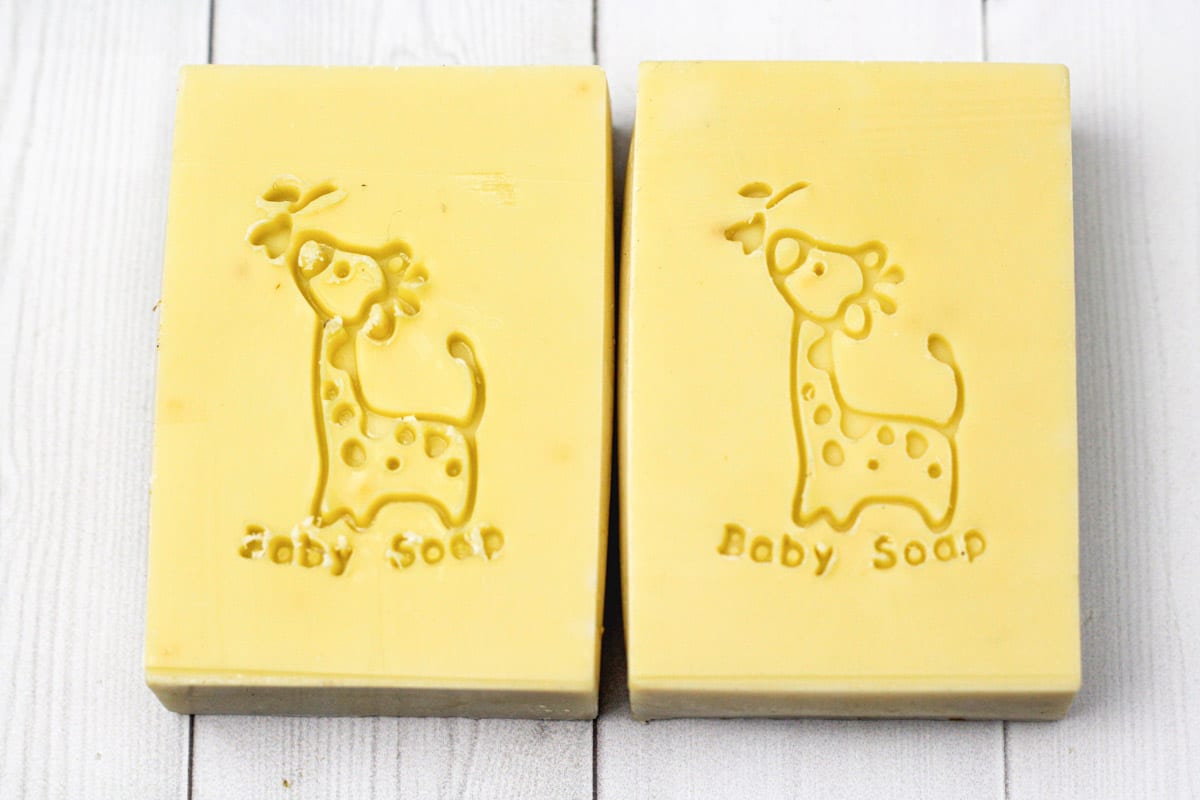
Here are the steps for getting a nice soap stamp design:
- Lay your soap on a hard flat surface
- Spritz the stamp with a little bit of rubbing alcohol; you might not have to do this after every stamping if you see there's still enough left
- Align stamp to where you want it to be on your soap
- Using the palm of your hand press down, so the stamp won't move when you use a mallet or hammer
- If you are using a mallet, tap (but not too hard) the stamp once in each corner and finish up by tapping in the middle once. If you're using a hammer, cover the stamp with a heavy towel first and then proceed pounding as outlined above
- Remove the stamp by first rocking it back and forth, then gently pulling it off the soap
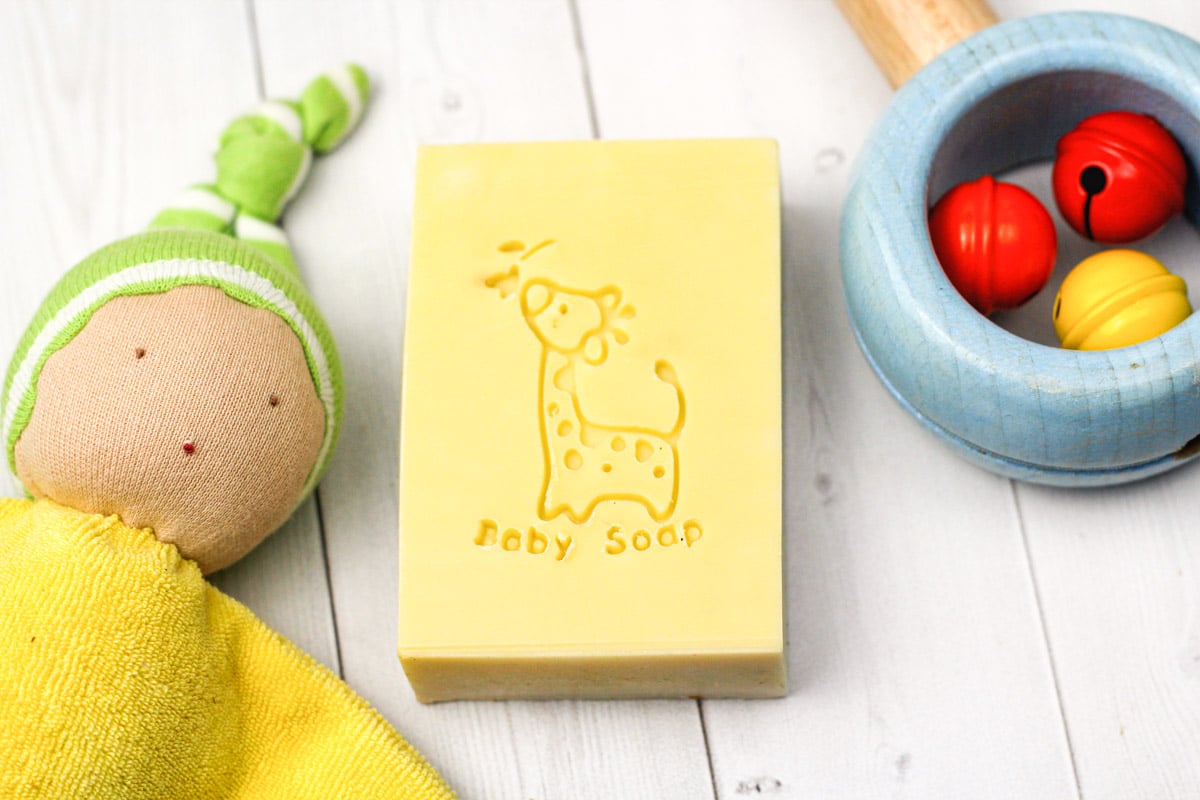
Disclaimer: This post contains affiliate links, meaning at no additional cost to you will I earn a commission if you click through and make a purchase.
If this is the first time making cold process soap I suggest you go back and check out my article about lye safety, equipment needed and my beginners tutorial.
Equipment needed:
- Two medium sized heat resistant containers
- One mason jar with lid
- Fine mesh sifter
- Coffee filter
- Accurate digital scale
- Immersion blender
- Single cavity soap mold
- Hammer (optional)
- Soap stamp "Baby Soap"(optional)
- Rubber mallet (optional)
- Small spray bottle for rubbing alcohol (optional)
Ingredients (for 6 bars of soap; 24 oz/680 g):
This baby soap recipe is superfatted at 7% and uses a lye concentration of 38%.
- Distilled Water: 3.56 oz/ 101 g
- Lye: 2.18 oz/ 62 g
- Olive Oil (70%): 12.35 oz/ 350 g
- Shea Butter (unrefined) (22%): 3.88 oz/ 110 g
- Castor Oil (8%): 1.41 oz/ 40 g
- Lavender Essential Oil: 12 g
- Chamomile Essential Oil: 4 g
- Colloidal Oatmeal: 1 ½ Tbsp
- Dried Chamomile Flowers: ¾ cup
Instructions:
- Place dried chamomile flowers in a mason jar until almost full
- Measure out olive oil and pour into mason jar so that chamomile is completely covered, close the lid and give it a shake
- To infuse the olive oil you can either leave the mason jar in a sunny window sill for 4 - 6 weeks or place it in a small saucepan with water over low heat for 2 hours
- Gear up for safety: gloves, googles are a must when dealing with lye!!!
- Prepare your lye solution by pouring the lye into the water, NEVER the other way around and set aside to cool
- Strain olive oil through a fine mesh sifter line with a coffee filter, an old shirt or cheese cloth
- Squeeze out as much olive oil as possible from the chamomile flowers at the end
- Weigh olive oil to make sure you have right amount, add more olive oil if not
- Melt shea butter in a water bath over low heat
- Add shea butter, olive oil and castor oil to a medium sized container
- Add colloidal oatmeal and essential oils and stick blend until well combined
- Add lye solution to base oils and stick blend until light pudding consistency is achieved
- Place your soap mold on a cutting board
- Pour the soap batter into the soap mold cavities
- Tap soap mold with cutting board down to release air bubbles
- Leave your soap out on the counter for 24 hours
- Unmold soaps and set out to dry
- After 4 days stamp your soaps (if desired):
- Lay your soap on hard flat surface
- Spritz the stamp with a little bit of rubbing alcohol; you might not have to do this after every stamping if you see there's still enough left
- Align stamp to where you want it to be on your soap
- Using the palm of your hand press down, so the stamp won't move when you use a mallet or hammer
- If your using a mallet pound (but not too hard) the stamp in each corner and finish up by pounding in the middle once. If you're using a hammer cover the stamp with a heavy towel first and then proceed pounding as outlined above
- Remove the stamp by first rocking it back and forth, then gently pulling it off the soap
- Cure for 6 weeks
Looking for more skin-loving soap recipes? Why not try:
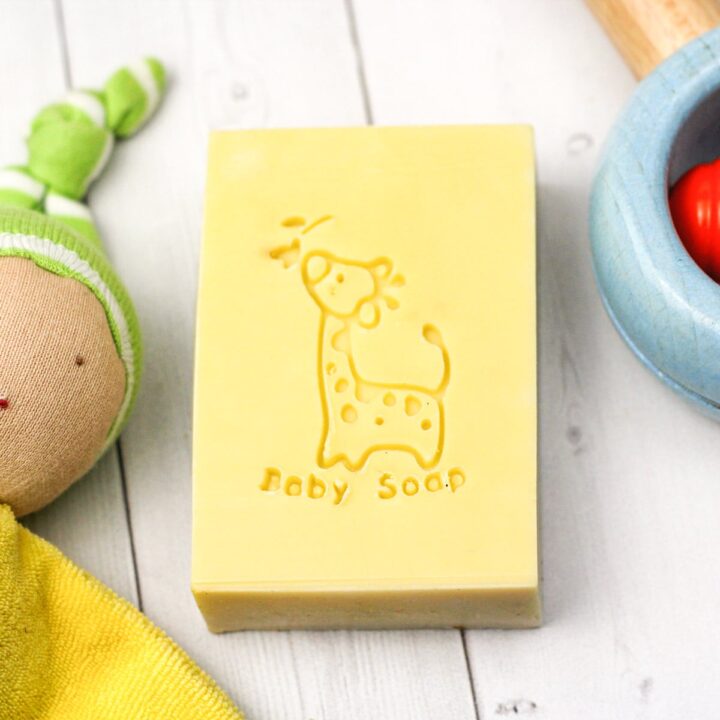
Gentle Bastille Baby Soap
A gentle baby soap recipe for everyone that has delicate sensitive skin - not just babies.
Materials
- Distilled Water: 3.56 oz/ 101 g
- Lye: 2.18 oz/ 62 g
- Olive Oil (70%): 12.35 oz/ 350 g
- Shea Butter (unrefined) (22%): 3.88 oz/ 110 g
- Castor Oil (8%): 1.41 oz/ 40 g
- Lavender Essential Oil: 12 g
- Chamomile Essential Oil: 4 g
- Colloidal Oatmeal: 1 ½ Tbsp
- Dried Chamomile Flowers: ¾ cup
Tools
- Two medium sized heat resistant containers
- One mason jar with lid
- Fine mesh sifter
- Coffee filter
- Accurate digital scale
- Immersion blender
- Single cavity soap mold
- Hammer (optional)
- Soap stamp “Baby Soap”(optional)
- Rubber mallet (optional)
- Small spray bottle for rubbing alcohol (optional)
Instructions
- Place dried chamomile flowers in a mason jar until almost full
- Measure out olive oil and pour into mason jar so that chamomile is completely covered, close the lid and give it a shake
- To infuse the olive oil you can either leave the mason jar in a sunny window sill for 4 – 6 weeks or place it in a small saucepan with water over low heat for 2 hours
- Gear up for safety: gloves, googles are a must when dealing with lye!!!
- Prepare your lye solution by pouring the lye into the water, NEVER the other way around and set aside to cool
- Strain olive oil through a fine mesh sifter line with a coffee filter, an old shirt or cheese cloth
- Squeeze out as much olive oil as possible from the chamomile flowers at the end
- Weigh olive oil to make sure you have right amount, add more olive oil if not
- Melt shea butter in a water bath over low heat
- Add shea butter, olive oil and castor oil to a medium sized container
- Add colloidal oatmeal and essential oils and stick blend until well combined
- Add lye solution to base oils and stick blend until light pudding consistency is achieved
- Place your soap mold on a cutting board
- Pour the soap batter into the soap mold cavities
- Tap soap mold with cutting board down to release air bubbles
- Leave your soap out on the counter for 24 hours
- Unmold soaps and set out to dry
- After 4 days stamp your soaps (if desired):
- Lay your soap on hard flat surface
- Spritz the stamp with a little bit of rubbing alcohol; you might not have to do this after every stamping if you see there’s still enough left
- Align stamp to where you want it to be on your soap
- Using the palm of your hand press down, so the stamp won’t move when you use a mallet or hammer
- If your using a mallet pound (but not too hard) the stamp in each corner and finish up by pounding in the middle once. If you’re using a hammer cover the stamp with a heavy towel first and then proceed pounding as outlined above
- Remove the stamp by first rocking it back and forth, then gently pulling it off the soap
- Cure for 6 weeks




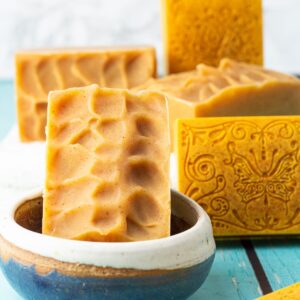
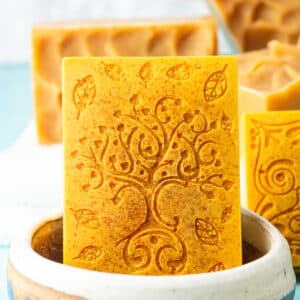
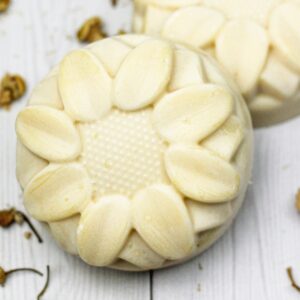
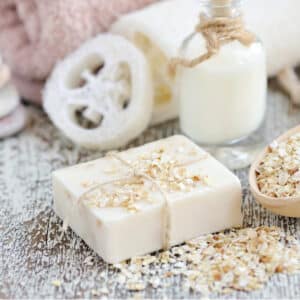
Cari
This recipe looks amazing! I love using chamomile infused oils in my recipes.
Rebecca Dillon
Bastille soap is amazing. I love that you included chamomile in this recipe.
Majo glow
Thank you so much for the Bastille soap. I love it
Celine
I’m glad to hear! Enjoy 🙂
Vicky
Hey. This looks fab. What temperature are you adding the oils and lye together? The instructions only heating up the butter, so I wanted to check. Thanks
Celine
Thank you Vicky! At around 110 F.
Vicky
Thanks Celine. Can't wait to try it. 🙂
Jennifer
Hi, Could you tell me if this recipe would be suitable for baby's hair too? I have used it on my baby's hair and I find that it's really nice but not sure if I should be marketing this soap in this way. Thank you!
Celine
Hi Jennifer, my family uses soap on their hair and love it. Personally I’m not using it on the baby yet since it’s not tear free and will sting if it gets into their eyes.
Kelly Stevens
Hi, this sounds like a lovely recipe. Can you tell me if that is a soap mold or a stamp you used? It's so cute.
Celine
I used soap stamps for these.
Sam
Hi! I was curious if this soap is super fatted at all? Thanks!
Celine
Hi Sam, yes it is at 7% .